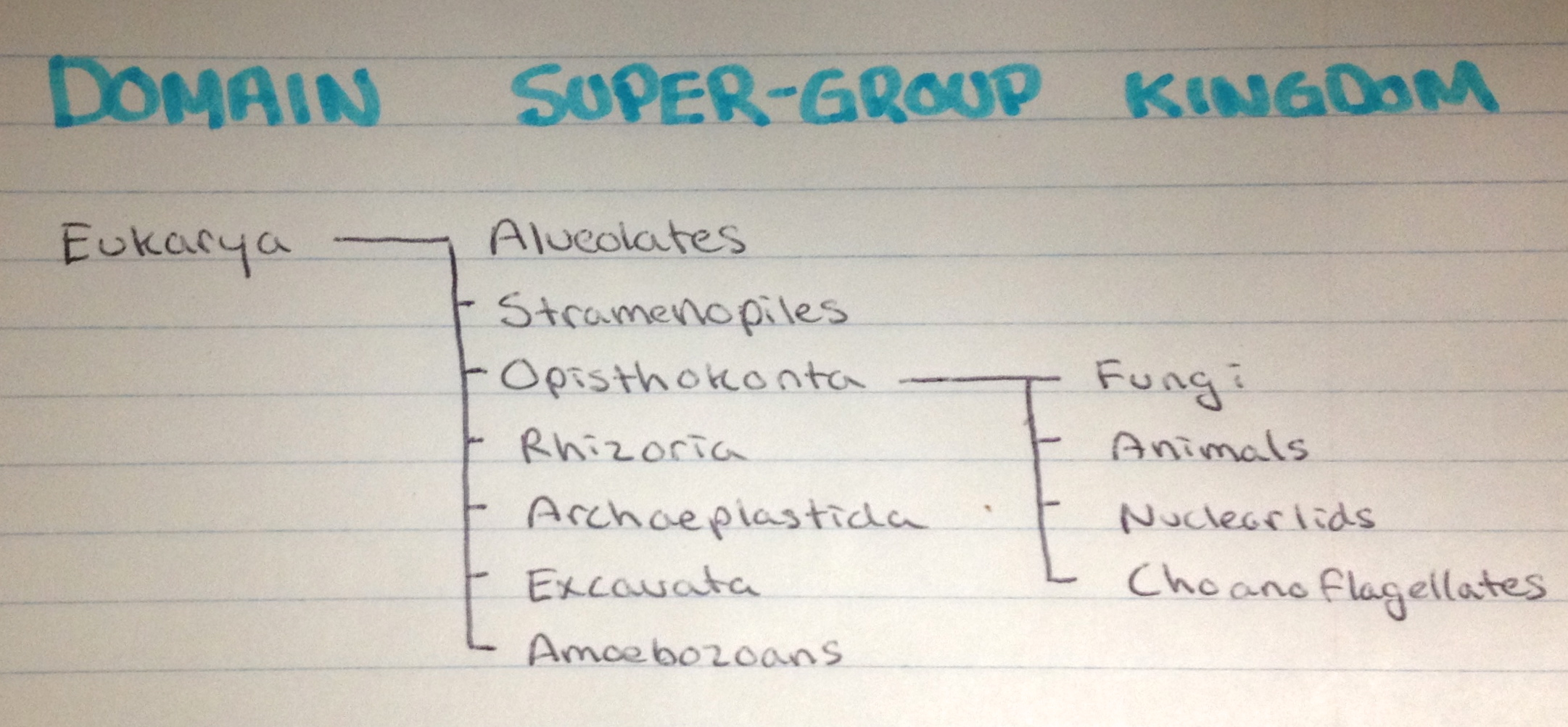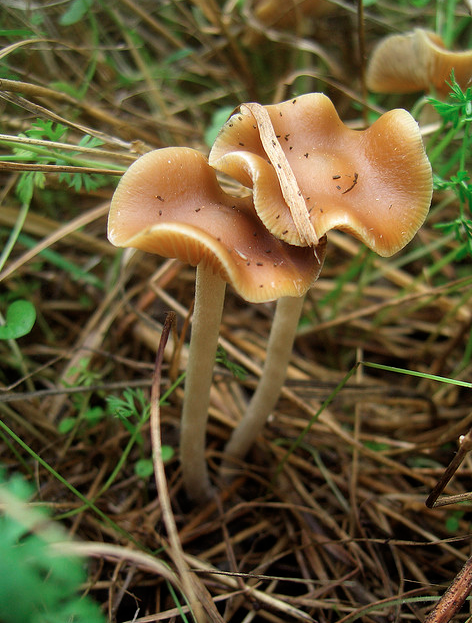Classification
Psilocybe cyanescens belongs to many phylogenetic categories, with a specific trait or purpose dignifying why this species is assigned to each specific group, for which greater detail will be explained for each corresponding category. It is important to note that each trait becomes significantly more specific, as the traits that make up each respective category become more specific. The evolutionary traits that make up this species, with its relation to other organisms can be explained here.
Doman : Eukarya
The domain Eukarya is made up of eukaryotic organisms, which are mainly multicellular organisms that have cells enclosed in membrane-bound organelles. However, there are some single celled organisms classified as eukaryote as well. Typically, eukaryotic organisms will also have advanced genetic material, such as multiple strands of DNA to encode for specific traits, which will also undergo evolutionary changes. This broad category also consists of protists, animals, and plants! Check out the web pages made by my peers in Organismal Biology on other unique Eukaryotic organisms. The page by Torin Boernke on Eciton hamatum (Army Ants), is very interesting, as is the page by Danielle Cook on Narcissus pseudonarcissus (Daffodil). All of these organisms are Eukaryotic, and possess the aforementioned features. Lastly, check out the page by Michael Gyrofi if you want to learn about the Lion's Mane Jellyfish, Cyanea capillata, an amazing marine organism! Continue reading below to see how P. Cyanescens is further broken down in its phylogeny.

Super-group: Opisthokonta
The super-group Opisthokonta is composed of a broad group of
eukaryotes, which encompasses the animal kingdom, along with other
eukaryotic microorganisms, as you can see further down on the
webpage. The common characteristic that all opisthokonts have is
that they possess flagellate cells, which are used to propel the
organism. However, this super-group is unique because the flagella
is posterior, which differentiates from all other groupings that
possess anterior flagellum.
Kingdom: Fungi
The kingdom Fungi is where the major distinctions occur that
separate animals, plants, and protists. The most unique
characteristic of all fungi is that their cell walls are composed of
chitin, which is a stark contrast from plants where the cell walls
are composed of cellulose. Fungi are very resilient, and can survive
in almost any environment. Therefore, no matter where you are in the
world, there is almost always a fungus with you too. Fungi are also
more closely related to animals than to plants, based on DNA
analysis of their taxonomy.
If you want to see more unique fungi, check out the web page by Alex
Johnson, on
Amanita phyalloids (Death Cap) and the web page by Willa Hammet-Hayes
on
Gyromitra esculenta (False Morel). Lastly, the webpage by Tom Duemke on
Conocybe filaris (Lawn Mushroom) and the webpage by Matt
Birschbach on
Amanita bisporigera (Destroying Angel) should provide interesting information on the
kingdom fungi. In conclusion, the kingdom fungi can be divided into seven phyla, which further
differentiates between the morphological and physiological function
of various species within the kingdom fungi.

Phylum: Basidiomycota
The phylum basidiomycota is one of the largest phyla within the
kingdom Fungi, and represents the majority of traditional mushroom
shaped fungal species. The main characteristic of basidiomycota is
that it has externally born spores on a club-shaped structure, known
as a basidium (hence the name of the phylum). The spores that are
born on the basidium are sexual spores, as it is rare but not
impossible for asexual spores to be reproduced. Another unique fungi
in the phylum Basidiomycota is
Schizophyllum commune, a split gilled fungus. The spores for basidium are found in convoluted areas in order to maximize surface
area to maximize spore production, which creates a large number of
offspring.
Class: Agaricomycetes
The class Agaricomycetes is a less diverse group of basidiospores, however every member of this group can vary in size
exponentially, as basidiocarps can range greatly in size. This
example of diversity is also evidenced with some members of agaricomyctes that take up an area of up to thirty-five acres, and
are older than one thousand years old. Many members of this class
produce fruiting bodies, however not all of the members do. Also, a
majority of the members are terrestrial bound, but there also are
some members that dwell in aquatic environments. As the phylogenetic
properties become more specific, there is less diversity between the
respective groupings of traits.
Order: Agaricales

The order Agaricales is best known for the
presence of gills under the cap (top component that connects to the
stem) of a mushroom. The majority of gilled mushrooms are found on
land, with the exception of one species that has been discovered
with fruiting bodies underwater. Fruiting bodies are the main method
of dispersal for reproduction practices, with spores being released
from the gills of the cap of the mushroom, after hyphae develops in
the proper development allowing for adequate growth to occur. The
main method of nutrient absorption occurs through the presence of
Also, agarics are found almost everywhere, and are very adaptable to
many environments, thus demonstrating their presence almost
everywhere on earth.
Flickr Creative Commons, January 28, 2010
Family: Strophariaceae
The family Strophariaceae is a part of the order Agaricales,
in which there is still moderate variation between various species
members. The spores that are released are similar in structure
however, as they are released through an apical germ pore, which is
a small outlet that permits the spores to be freed into the external
environment from the gills. Also, all of the various species within
the strophariaceae family survive on decomposing material. Check out
the illustration below and to the left to see if you can identify
the various components of the mushroom in the diagram, in particular
look for the mushroom cap, stem, gills, and spores releasing into
the external environment. If you need help that is okay, just look
at the illustration with labels to the right. If you are
able to identify the major components, then you are already able to understand the basic
components of the life cycle of mushrooms! Click
here to see a complete
explanation on the life cycle of
P. Cyanescens.


Genus:
Psilocybe
The genus Psilocybe
refers to the grouping of small sized mushrooms, which all contain
psychoactive compounds called psilocin and psilocybin. These
compounds are responsible for the hallucinogenic properties of many
of the mushrooms contained in this genus. The word "Psilocybe"
is of Greek origin, and refers to the mushroom cap's loose skin
covering. Although Psilocybe
can be found all over the world, they are a small sized mushroom,
and can be distinguished for their ability to turn blue when
handled, which actually is a bruise forming on the stem of the
mushroom. If you want to learn more about the genus Psilocybe,
check out the way page by Luke Bielmeiser on
Psilocybe cubesesis, another amazing fungus! There are a large number of mushrooms in the genus
Psilocybe, all
differentiated based on molecular differences in morphology.
Species: Psilocybe cyanescens
The species Psilocybe
cyanescens is defined by its

wavy caps and potent psychoactive
compounds contained
within the mushroom fruiting body. It is
described as the
"potent
Psilocybe", for the composition of two main
psychoactive
compounds found in its respective genus.Also, the population of P. cyanescens is becoming spread with increasing prevalence across the
world, mainly due to mulch being used in undeveloped areas that
contained the mycelium, thus allowing for fruiting bodies to grow,
and in turn releasing spores into the new environment which only
further increases the population.
P. cyanescens fruiting
bodies mature in the fall when the temperature begins to steadily
decrease, and large colonies are not uncommon to discover in
California and dispersed throughout Europe.
Flickr Creative Commons, Oct 28, 2006
Also, it is important to note that because this species of
mushroom contains psychoactive compounds, it has become increasingly
popular for recreational drug users to cultivate
P. cyanescens spores.
Another organisms that is popular to cultivate in the United States
is Cannabis sativa and Cannabis indica, which is
marijuana. For more information on that species see the webpage by
Spencer Williams on
Cannabis sativa x indica. As
the spores develop mycelium, a proper substrate and growing
environment are incorporated in the process, in turn producing
fruiting bodies, which can be harvested, dried, and consumed.
However this process of cultivating genus
Psilocybe mushrooms is
illegal in the United States, and is strongly discouraged for lawful
reasons.
If you are interested in the phylogeny of the organism, as discussed
above, continue to the habitat
page, where you can learn more about this intriguing organism,
including its interactions with other organisms. If you would like
to go back a page, click on the home
link.
